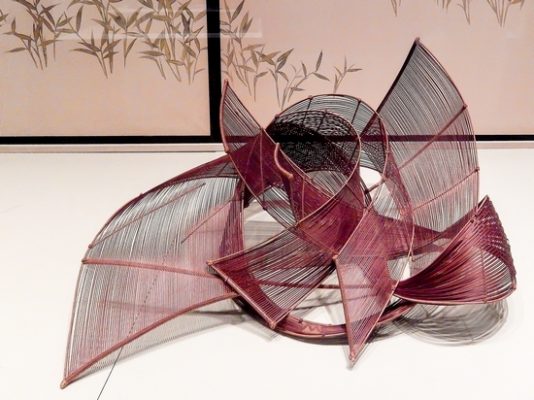Original article at NY Press.com
Entering The Met Fifth Avenue’s Arts of Japan galleries, many visitors can’t help but gasp. We did. The guard on duty said it’s a common response. The exhibition title and signage promised bamboo baskets. It didn’t say anything about a floor-to-ceiling twisting mass of frenetic energy in a site-specific installation by Tanabe Chikuunsai IV.”The Gate,” woven of tiger bamboo, torques and twirls like a funnel cloud, or the tendrils of a great vine, or the circulatory system of some unseen giant. It’s at once ethereal and overpowering, weightless and crushing. It’s extraordinary.
At home, our kitchen counter usually holds two or three bamboo baskets filled with bananas and apples or unsorted mail. It was clear from this introduction that the work in the exhibition that followed would have little to do with our everyday experience of bamboo.
Japanese Bamboo Art: The Abbey Collection” highlights some 90 works in bamboo, from functional baskets to abstract sculptures, that date from the late 1800s to the present. It’s The Met’s first exhibition focusing on basketry, and most of the works have never been on public view before. New York residents Diane and Arthur Abbey have amassed one of the most comprehensive and exquisite collections of a form that has only recently been considered fine art. Yet, six of the artists whose work is on view have been recognized in Japan as Living National Treasures.
From delicate grasses to timber towering five stories high, the more than 60 varieties of bamboo that are native to Japan have become woven into the arts, culture and daily lives of the society for hundreds of years. Its shoots are a dietary staple, and it’s been used to make kitchen utensils, furniture, hats and shoes, transportation devices for everything from medicine to travelers, and even bridges, roads and buildings. Called one of the “three friends of winter,” along with pine and plum trees, bamboo doesn’t succumb to cold, grows quickly, and bestows its gifts to animals and humans with grace. It bends without breaking and is thought of as steadfast and loyal. For all these reasons, the venerable and venerated plant has been depicted and utilized by artists for ages.
One of the pleasures of the exhibition is the engaging way that curator, Monika Bincsik, has woven the Abbeys’s baskets through a presentation of The Met’s superb collection of screens, woodblock prints, Inrō containers, manuscripts and ceramics. Each gallery contains conversations between basketry and other objects, expressed in the language of bamboo, but with almost infinite dialects and inflections. One case presenting a glorious painted manuscript had me wondering what it was doing there, until I read the title of the story: “The Tale of the Bamboo Cutter.” Bamboo imagery throughout the galleries decorates delicate fans, massive folding screens and antique porcelains.
But it’s the baskets that carry the exhibition. Many were created to hold ikebana floral arrangements, a classical art of spiritual refinement. They range from minutely detailed to radically abstract, and from traditional to uncompromisingly contemporary. “Tide,” a 1978 work by Fujitsuka Shōsei, displaying the “thousand line” technique is beautifully placed in front of a screen decorated with painted bamboo leaves. Nagakura Ken’ichi’s “Woman Flower Basket,” tall and spindly, recalls a Giacometti figure. A dramatically lit, black-lined case holding two objects is a show stopper. In “Wave,” created by Monden Kōgyoku in 1981, a rolling mass of energy coils in on itself. Next to it is the 2000 work, “Dance,” by Honda Shōryū. It pliés and twirls with elegance, precision and grace.
“Japanese Bamboo Art: The Abbey Collection” presents a sweeping view across centuries and media with spectacular forms expressing a humble and hardy, but hardly plain plant.

